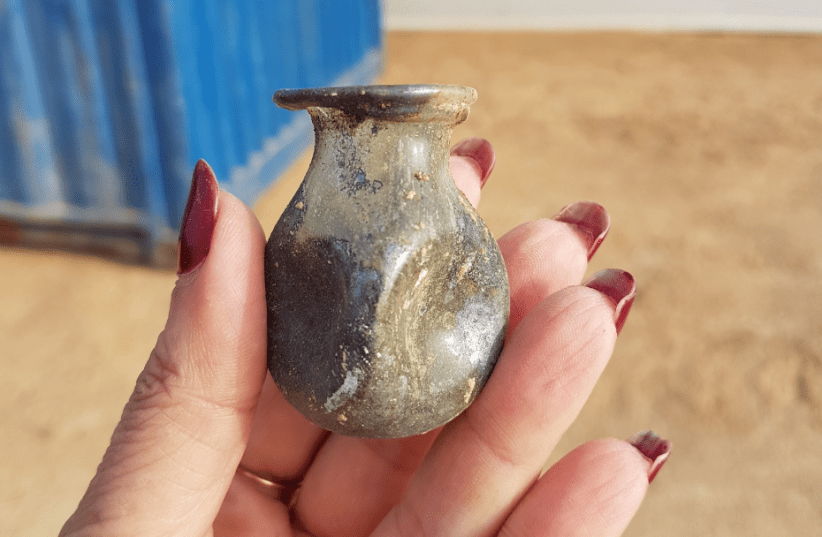African Figurines Shed Light on Early Christian Life in Negev, Israel

Dark-colored and ivory pendants shaped like African men and women were found in three graves dating back to the sixth-seventh century CE at Tel Malḥata, located southeast of Beersheba. This research was published in volume 117 of the Israel Antiquities Authority (IAA) journal. ‘Atiqot Links the artifacts to long-distance commerce and to inhabitants who either had ancestral roots or memories reaching back to Africa while practicing Christianity in the Roman-Byzantine Negev.
Dr. Noé D. Michael from the University of Cologne and the IAA, along with Svetlana Talis, Dr. Yossi Nagar, and Emil Aladjem from the IAA, spearheaded the research effort. The study details five artifacts—a trio made of bone and a pair crafted from ebony—that were unearthed between 2016 and 2017 through rescue excavation efforts within a military area covering an ancient burial ground.
About 155 graves were discovered by archaeologists in what appears to be a cemetery following Christian traditions. The majority of these burial sites consist of stone-lined cists aligned from east to west, containing bodies positioned face-up with their heads facing westward and arms folded across their chests. Artifacts found within the graves predominantly accompany females and children; roughly two-thirds of all grave items belonged to these categories, whereas male individuals seldom had jewelry buried alongside them.
Three cist graves were the origin of these figurines. Grave 162 was occupied by a female who died around the age of eighteen to twenty-one years old. Near her remains, archaeologists found a solitary bone pendant alongside several glass containers and a bronze bracelet. In contrast, Grave 178 housed another adult woman estimated to be between twenty and thirty years old when she passed away. This tomb produced two alabaster jars along with various pieces of jewelry including a set of pendants: one made of bone and the other crafted from ebony wood. Lastly, Grave 179 had the skeletal remains of a young child approximately six to eight years old. Within this grave, researchers discovered both a bone carving and an ebony piece positioned within the curve of the child’s left arm as well as atop their lower torso next to some ornamental bronze items.
The three bone amulets are cylindrical carvings made from metapodial bones, smoothed and drilled for suspension with a string. Their heights vary between 1.95 cm and 3.15 cm. Basic engraved lines depict eyes, mouths, and limbs, but no traces of coloring remain.
The dark wooden components received particular scrutiny. An optical microscope inspection of a sample revealed that the material was ebony wood. Diospyros ebenum The Ceylon ebony originates from South India and Sri Lanka. This particular piece includes a sizable ebony sculpture measuring 2.75 cm tall, depicting a male upper body with distinctively detailed African facial characteristics. There’s also a fragmented female head, standing at 1.5 cm tall, which aligns closely with the first figure in terms of size and craftsmanship. Each artifact has perforations for hanging purposes.
The trade studies mentioned in the document indicate that maritime paths connecting Egypt, the Horn of Africa, and South Asia transported valuable goods such as ebony, pepper, cotton, and silk into the eastern Mediterranean starting from the fourth century CE. Afterward, caravans conveyed these high-value commodities through the Negev passages converging at Tel Malḥata— one route extending northwards from Aila on the Gulf of Aqaba, and another traversing east-west between Gaza and the Dead Sea.
The research team posits that these pendants were likely personal items connected to familial identity instead of being part of temple or church gear. Noting how Greco-Roman scribes often lumped various African groups into one category called "Ethiopians," and considering the spread of Christianity across Axum and Nubia during Emperor Justin I’s and Justinian’s rule, they speculate whether the individual buried here or their forebears came from Africa, bringing along traditional emblems post-conversion in the Negev region.
Every burial site included extra gifts. Tomb 162 revealed glass artifacts; Tomb 178 had two alabaster containers placed next to the head and upper body; Tomb 179 provided bronze bangles along with pendants. The positioning of objects close to the hands, midsection, and legs adhered to layouts documented across the necropolis.
The extensive graveyard encompasses various burial methods ranging from lined cists and pit graves to seven crematorium pits which might date back to the earliest phases of the Roman period. Artifacts like pottery and minor objects indicate usage from the third century CE through the early Umayyad times; however, the Christian design along with the inclusion of high-end imported items situates the three figural tombs within the latter part of the sixth or beginning of the seventh century.
In a Facebook post announcing the release, the IAA mentioned that the pendants "hold tales of heritage and recollections" and "serve as reminders that the land of Israel has consistently served as a confluence of various cultures." IAA Director Eli Eskosido further noted that this discovery highlights how immigrants assimilated local traditions while maintaining connections to their far-off origins.
The piece was crafted with help from a news analysis tool.
Post a Comment for "African Figurines Shed Light on Early Christian Life in Negev, Israel"
Post a Comment